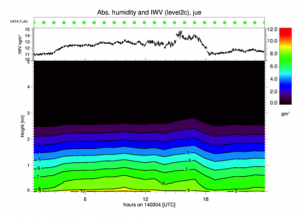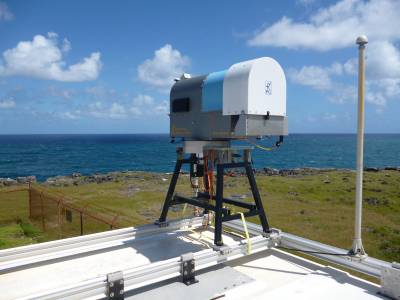This is an old revision of the document!
Table of Contents
HATPRO (Humidity and Temperature Profiler) is a microwave radiometer remote sensing instrument detecting thermal emission from the atmosphere. We currently operate three HATPRO devices:
- SNOHAT at the Schneefernerhaus observatory (Mt. Zugspitze)
Introduction
The atmosphere in the microwave spectral range (MW) between 1 and 300 GHz is semi-transparent. This means its components like dry gases, water vapor, or hydrometeors interact with MW radiation but overall even the cloudy atmosphere is not completely opaque in this frequency range. Microwave radiometers are very sensitive receivers usually equipped with multiple receiving channels in order to derive the characteristic emission spectrum of the atmosphere. Microwave radiometers are utilized in a variety of environmental and engineering applications, including weather forecasting, climate monitoring, radio astronomy, as well as monitoring of land and ocean surface properties.
For weather and climate monitoring, microwave radiometers are operated from space [1] [2] as well as from the ground [3]. As remote sensing instruments, they are designed to operate continuously and autonomously often in combination with other atmospheric remote sensors like for example cloud radars and lidars. They allow to derive important meteorological quantities such as vertical temperature and humidity profile, columnar water vapor amount, or columnar liquid water path with a high temporal resolution in the order of seconds to minutes under nearly all weather conditions.
RPG HATPRO-SUNHAT at the Barbados Clouds Observatory.
History of microwave radiometer measurements
The first operational microwave radiometer was designed by Robert H. Dicke in the Radiation Laboratory of Massachusetts Institute of Technology to better determine the temperature of the microwave background radiation. This first radiometer worked at a wavelength 1.25 cm and was operated at the Massachusetts Institute of Technology. Dicke also first discovered weak atmospheric absorption in the MW using three different radiometers (at wavelengths of 1.0, 1.25 and 1.5 cm).
Soon after satellites were first used for observing the atmosphere, MW radiometers became part of their instrumentation. In 1962 the Mariner-2 mission was launched by NASA in order to investigate the surface of Venus including a MW radiometer for water vapor and temperature observations. In following years a wide variety of MW radiometers were tested on satellites. The launch of the Scanning Multichannel Microwave Radiometer (SMMR) in 1978 became an important milestone in the history of radiometry. It was the first time a conically scanning radiometer was used in space; it was brought in space on board of the NASA Nimbus satellite [4]. The launch of this mission gave a unique opportunity to image the Earth at a constant angle of incidence. In the beginning of 1980, new multi-frequency, dual-polarization radiometric instruments were developed. Two spacecraft were launched which carried instruments of this type: Nimbus-7 and Seasat. The Nimbus-7 mission results allowed to globally monitor the state of ocean surface as well as surface covered by snow and glaciers. Today, radiometers are widely used not only onboard different satellites but also as ground-based instruments integrated in worldwide observational networks.
Principle of operation
Solids, liquids (e.g. the earth's surface, ocean, sea ice, snow, vegetation) but also gases emit and absorb MW radiation. Traditionally, the amount of radiation a microwave radiometer receives is expressed as the equivalent blackbody temperature also called brightness temperature (TB). The atmospheric components emit and absorb MW radiation in different ways: Atmospheric gases provide specific absorption features (Fig. 1) which allow to derive information about their vertical profile. Examples for such absorption features are the oxygen absorption complex (caused by magnetic dipole transitions) around 60 GHz which is used to derive temperature profiles or the water vapor absorption line around 22.235 GHz (dipole rotational transition) which is used to observe the vertical profile of humidity. Other significant absorption lines are found at 118.75 GHz (oxygen absorption) and at 183.31 GHz (water vapor absorption, used for water vapor profiling under dry conditions or from satellite). Weak absorption features due to ozone are also used for stratospheric ozone density and temperature profiling [7].
The emission and absorption of hydrometeors does not provide characteristic absorption line features as found for atmospheric gases. Liquid hydrometeors (small cloud and rizzle drops) are efficient emitters in the microwave. A microwave radiometer with only two frequencies, one close to the water absorption line (22.235 GHz) and one in the nearby window region (typically 31 GHz) can be used to derive the columnar amount of water vapor and the columnar amount of liquid water separately(two-channel radiometer).
Larger rain drops as well as larger frozen hydrometeors (snow, graupel, hail) also scatter microwave radiation especially at higher frequencies (>90 GHz). These scattering effects can be used to distinguish between rain and cloud water content [10] but also to constrain the columnar amount of snow and ice particles from space [11] and from the ground [12].
![Microwave spectrum: The black lines show the simulated spectrum (in brightness temperatures TB) for a ground-based receiver; the colored lines are the spectrum obtained from a satellite instrument over the ocean measuring at horizontal (blue) and vertical (red) linear polarization. Solid lines indicate simulations for clear-sky (cloud-free) conditions, dotted lines show a clear-sky case with a single layer liquid cloud. The vertical lines indicate typical frequencies used by satellite sensors like the [[https://en.wikipedia.org/wiki/Advanced_Microwave_Sounding_Unit|AMSU]] radiometer. Microwave spectrum: The black lines show the simulated spectrum (in brightness temperatures TB) for a ground-based receiver; the colored lines are the spectrum obtained from a satellite instrument over the ocean measuring at horizontal (blue) and vertical (red) linear polarization. Solid lines indicate simulations for clear-sky (cloud-free) conditions, dotted lines show a clear-sky case with a single layer liquid cloud. The vertical lines indicate typical frequencies used by satellite sensors like the [[https://en.wikipedia.org/wiki/Advanced_Microwave_Sounding_Unit|AMSU]] radiometer.](/ag_crewell/lib/exe/fetch.php?w=600&tok=64eb43&media=instruments:hatpro:mwr_5.png)
Microwave spectrum: The black lines show the simulated spectrum (in brightness temperatures TB) for a ground-based receiver; the colored lines are the spectrum obtained from a satellite instrument over the ocean measuring at horizontal (blue) and vertical (red) linear polarization. Solid lines indicate simulations for clear-sky (cloud-free) conditions, dotted lines show a clear-sky case with a single layer liquid cloud. The vertical lines indicate typical frequencies used by satellite sensors like the AMSU radiometer.
Design
The principal components of a microwave radiometer often follow a similar design and can be grouped into: antenna system, microwave radio-thermal receiver, recording and storage devices and a final processing unit. Usually ground-based radiometers are also equipped with environmental sensors (rain, temperature, humidity) and GPS receivers (time and location reference). The antenna itself often measures through a window made of foam which is transparent in the MW (light blue material in Fig. 1) in order to keep the antenna clean of dust, liquid water and ice. Often, also a heated blower system is attached the radiometer which helps to keep the window free of liquid drops or dew (strong emitters in the MW) but also free of ice and snow.
Calibration
Retrieval of temperature and water vapor profiles
The retrieval of physical quantities (e.g. temperature or water vapor profiles) is not straight-forward and comprehensive retrieval algorithms (using inversion techniques like optimal estimation approach) have been developed.
Temperature profiles are obtained by measuring along the oxygen absorption complex at 60 GHz. The emission at any altitude is proportional to local temperature and density of oxygen. Unlike water vapor, oxygen is relatively homogeneously distributed within the atmosphere and around the globe. Thanks to the relatively well known vertical profile of oxygen concentration, the TB signals can be directly used to derive the unknown temperature profile. Signals at the center of the absorption complex are dominated by the atmosphere closest to the radiometer (only the first hundred meters above the instrument). Moving more into the window region, the signal is a superposition from close and more distant regions of the atmosphere. The combination of several channels contains therefore information about the vertical temperature distribution. A similar approach is used to derive vertical profiles of water vapor utilizing the absorption line at 22.235 GHz.
 |  |
 |  |
Time series from the 14th April 2015 for (a) brightness temperatures measured at 7 different frequencies in the K (right) and V (left) bands, (b) retrieved vertically Integrated Water Vapor (IWV) and cloud Liquid Water Path (LWP), © temperature profiles from 0 to 5 km, (d) absolute humidity profiles from 0 to 5 km.
MWRnet
MWRnet is a network established in 2009 of scientists working with ground-based microwave radiometers. MWRnet aims to facilitate the exchange of information in the MWR user community fostering the participation to coordinated international projects. In the long run, MWRnet’s mission aims at setting up operational software, quality control procedures, data formats, etc. similar to other successful networks such as EARLINET, AERONET, CWINDE.
![Distribution of ground based microwave radiometers across the globe by type [3] Distribution of ground based microwave radiometers across the globe by type [3]](/ag_crewell/lib/exe/fetch.php?w=400&tok=1eb910&media=instruments:hatpro:mwr_3.png)
Distribution of ground based microwave radiometers across the globe by type [3]
References
- http://juno.wisc.edu/spacecraft_instruments_MWR.html (INAKTIVE LINK!)
- Thermal Microwave Radiation: Applications for Remote Sensing, C. Matzler, 2006, The Institution of Engineering and Technology, London, Chapter 1.
- Eugene A. Sharkov, “Passive Microwave Remote Sensing of the Earth”, Physical Foundations, Springer-Praxis Books in Geophysical Sciences, Chapter 14: Passive microwave space missions
- Cimini et al., 2009
- Klein and Gasiewski, 2000
- Eugene A. Sharkov, “Passive Microwave Remote Sensing of the Earth”, Physical Foundations, Springer-Praxis Books in Geophysical Sciences, Chapter 3: Microwave radiometers: functions, design, concepts, characteristics [http://www.iki.rssi.ru/asp/pub_sha1/pub_sha1.htm] (INAKTIVE LINK!)
- Czekalla et al., Discrimination of cloud and rain liquid water path by groundbased polarized microwave radiometry, GRL, 2001, DOI: 10.1029/2000GL012247
- Bennartz, R., and P. Bauer (2003), Sensitivity of microwave radiances at 85–183 GHz to precipitating ice particles, Radio Sci., 38(4), 8075, doi:10.1029/2002RS002626.
- Kneifel et al., Snow scattering signals in ground-based passive microwave radiometer measurements, JGR, 2010, DOI: 10.1029/2010JD013856


![Schematic diagram of a microwave radiometer [8]. Schematic diagram of a microwave radiometer [8].](/ag_crewell/lib/exe/fetch.php?w=400&tok=d64583&media=instruments:hatpro:mwr_4.png)